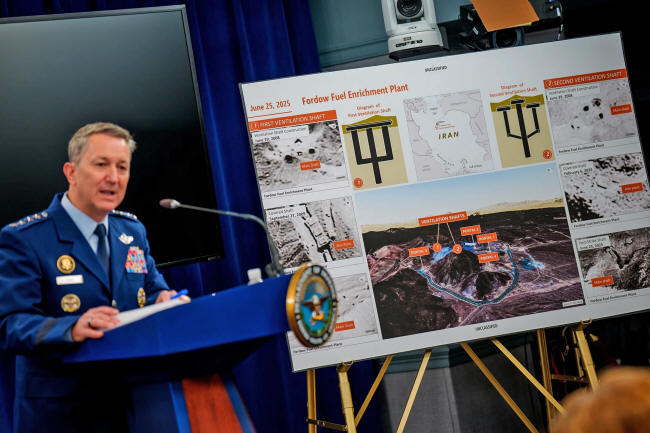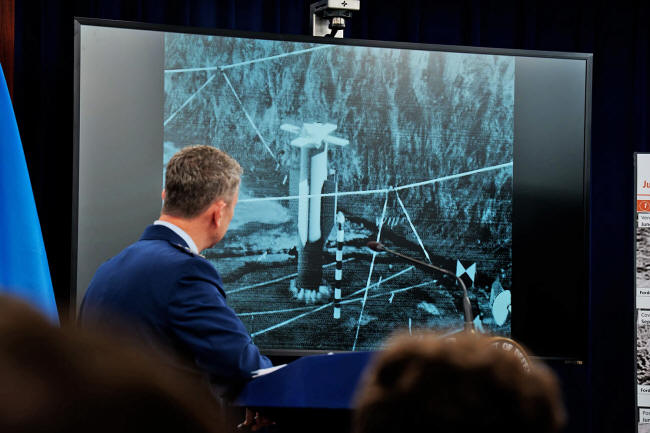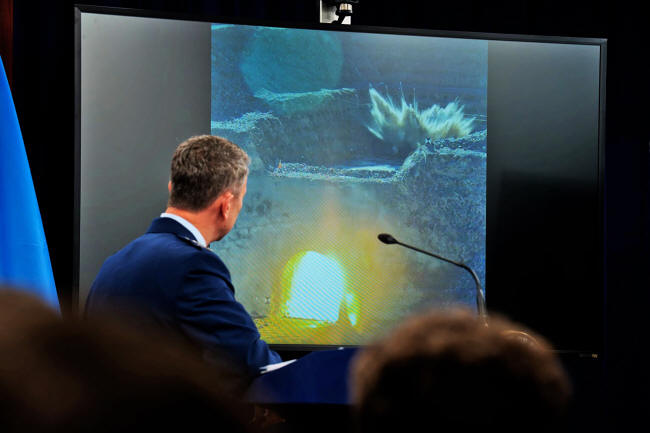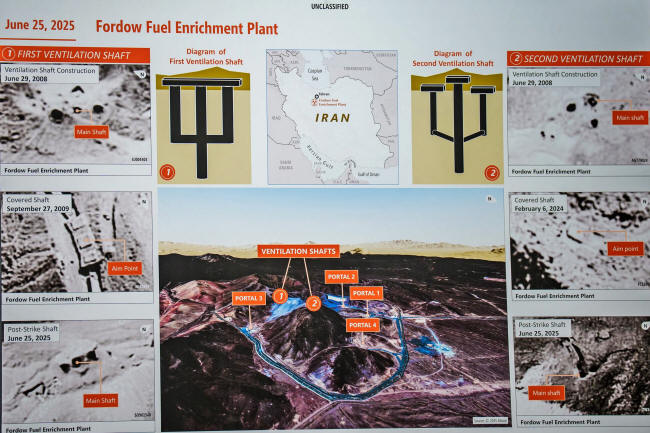|

by Anne Flaherty and Luis Martinez
ABC News' Chris Boccia
contributed to this report.
June 26, 2025
from
ABCNews Website

Hegseth slams news
coverage
of US intel report on
Iran attack.
Secretary of Defense
Pete Hegseth
said in a press
conference on Thursday morning
that the bombing of
Iran was the most
"complex and
secretive military operation in history."
Officials
unveiled Details about
a 15-year
Top-Secret program...
The Pentagon on Thursday released an extraordinary number of details
about the military's top-secret bombing
of Iran's nuclear facilities and
its defense of an air base in Qatar.
The unusual disclosures - including analysts briefed at secret
locations, bombs dropped into ventilation shafts, and a small group
of young service members left behind at a base to shoot down Iranian
missiles - is being orchestrated by a White House angry over
questions about the effectiveness of the U.S. strike, which targeted
three Iranian nuclear targets on June 21.
Trump insists Iran's nuclear program has been "obliterated,"
while an early military intelligence assessment said the strike
might only have set back Iran's program by "months."
Military officials say they need much more time
to assess the damage.
Here's what we've learned...
There was a 15-year, top-secret
mission to figure out how to destroy Iran's Fordo nuclear facility
In 2009, a U.S. officer working for the Defense Threat Reduction
Agency was brought into a vault at an undisclosed location and
shown highly classified photos of a construction site in the Iranian
mountains, according to Gen. Dan Caine, chairman of the Joint
Chiefs of Staff.

Chairman of the Joint Chiefs of
Staff Air Force Gen. Dan Caine
appears during
a news conference at the Pentagon
on June 26,
2025 in Arlington, Virginia.
Andrew Harnik/Getty Images
Caine said the officer and another colleague would go on to spend 15
years studying the site.
They analyzed the weather and the geology of the
mountain, along with any items discarded from the site.
They eyed ventilation shafts, electrical systems
and environmental control systems too, he said.
"Every nook, every crater, every piece of
equipment going in and every piece of equipment going out - they
literally dreamed about this target at night when they slept,"
Caine said.
When the analysts realized they did not have a
weapon to strike
Fordo if needed, Caine said they
teamed up with industry in a top-secret effort to build the
Massive Ordnance Penetrator, or
GBU-57, specifically to hit it.

Chairman of the
Joint Chiefs of
Staff Air Force Gen. Dan Caine
turns to
watch a video of a bombing test of the
GBU-57A/B
Massive Ordnance Penetrator
used in the
attack on the
Iranian
Fordow Fuel Enrichment Plant
during a news
conference at the Pentagon,
June 26, 2025,
in Arlington, Virginia.
Andrew Harnik/Getty Images
"Then, on a day in June of 2025, more than
15 years after they started their life's work, the phone
rang and the president of the United States ordered the B-2
force" to strike the target, Caine said.
One of them later told Caine,
"I can't even get my head around this."

Chairman of the Joint
Chiefs of Staff
Air Force Gen. Dan
Caine
turns to watch a
video of a bombing test of the
GBU-57A/B Massive
Ordnance Penetrator
used in the attack on
the Iranian
Fordow Fuel
Enrichment Plant
during a news
conference at the Pentagon,
June 26, 2025, in
Arlington, Virginia.
Andrew Harnik/Getty Images
12 Bombs were
dropped down two Ventilation Shafts capped with concrete
In a bid to defend the strikes as successful, both Secretary of
State Marco Rubio and Defense Secretary Pete Hegseth
in recent days have publicly disclosed that 12 of the 14 Massive
Ordnance Penetrators used in the June 21 strike were dropped on
the nuclear facility at Fordo.
At the briefing on Thursday, Caine went further, describing
that six bunker-buster bombs were dropped down each of the two
ventilation shafts with fuses programmed to detonate at specific
times.
Caine said the Iranians had covered the ventilation shafts with
concrete caps, but the first bomb blew off the caps.
After that, the next four bombs were programmed
to drop more than 1,000 feet per second and,
"explode in the mission space."
The final bomb was designated as a,
"flex weapon," or backup, he said.
"All six weapons at each vent, at Fordow went
exactly where they were intended to go," Caine said, adding that
the result was "a mix of overpressure and blast ripping through
the open tunnels and destroying critical hardware."
Caine said the fighter pilots who trailed the B-2
bombers said that after the first bomb struck the target,
"the pilots stated, quote, this was the
brightest explosion that I've ever seen. It literally looked
like daylight."

A poster of the
Fordow Fuel
Enrichment Plant is displayed
as Chairman of
the
Joint Chiefs of
Staff Air Force Gen. Dan Caine
and Defense
Secretary Pete Hegseth
hold a news
conference at the Pentagon,
June 26, 2025
in Arlington, Virginia.
Andrew Harnik/Getty Images
DIA says Fordo damaged - But
questions remain on impact to Iran's Nuclear Program
About a day after the attack, the Defense Intelligence Agency
(DIA) produced an early assessment estimating Iran's nuclear program
was set back by "months."
According to the two people familiar with the classified report, the
bombing sealed off the entrances to two of the three nuclear sites
targeted in the attack but that most of the damage was done to
structures above ground, leaving the lower structures intact.
The assessment also found that at least some
enriched uranium remained - possibly moved from the nuclear sites
ahead of the blasts.
President
Donald Trump insists the
enriched uranium wasn't moved in advance.
Hegseth, visibly angry that details of the report had leaked,
said,
"new intelligence" estimates the Iran program
has been knocked back by "years," not months, and he read from
the classified assessment to reporters.
"It points out that it's not been coordinated with the
intelligence community at all," said Hegseth, adding that the
report was labeled "low confidence."

Defense Secretary
Pete Hegseth
speaks during a news
conference at the Pentagon,
June 26, 2025
in Arlington, Virginia.
Andrew Harnik/Getty Images
A couple of dozen Service Members
in their 20s defended a U.S. Airbase in Qatar
Two days after the strike, U.S. officials got word that Iran was
planning to launch a retaliatory attack on an American
air base in Qatar called al-Udeid.
According to Caine, officials quickly evacuated the base in part of
extend the security perimeter, leaving behind two
Patriot missile batteries and some
44 soldiers.
Of the troops left to defend the base, the oldest was a 28-year-old
captain.
Caine said the group listened to "chatter" of the impending attack
in the oppressive heat and were told to ensure their missile
batteries were pointed north.
Iran began launching short- and medium-range
missiles,
prompting the soldiers to unleash "round
after round" of Patriot missiles from their canisters.
Caine called the operation the,
"largest single Patriot engagement in U.S.
military history," noting the Qataris aided in the defense.
"I'm not going to tell you how many rounds were shot," Caine
said, noting the number was classified, "but it was a bunch."
Video
Video also
HERE,
HERE and
HERE...
|







